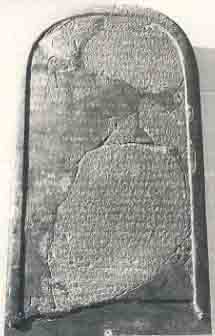Image Details

Louvre Museum
The Mesha stela claims a ninth-century B.C.E. victory for the Moabite king Mesha over the Israelites. Mesha says he conquered Israelite territory east of the Jordan and humiliated the tribe of Gad. Among the mentioned towns was the place where the stela was found in 1868, the city of Dibon. 2 Kings 3:4 tells of a ninth-century Moabite rebellion, but it may not be the same as the fighting recorded on the Mesha stela.
Made of black basalt, the Mesha stela stood about 3 feet high. The 34 lines of Moabite script in the Moabite language (very close to Hebrew) make the Mesha stela the longest monumental inscription ever found in Palestine. Shortly after its discovery, the stela was smashed. A young French diplomat and amateur archaeologist, Charles Clermont-Ganneau (1846–1923) tracked down and acquired the pieces and attempted to reconstruct the stela. In the photo, the smooth areas of the stela mark Clermont-Ganneau’s reconstructions based on a paper impression made before the stela was smashed.
